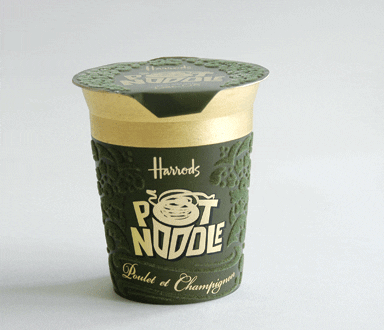
words William Wiles
A surefire way to get some free tabloid publicity for your shop or restaurant is to take a cheap, staple element of the Western diet – fish and chips, for instance – and “reinvent” it in a luxury format by cramming it full of wagyu beef, Périgord truffles and flakes of edible gold leaf and pricing it out of the reach of the average consumer. Mid-market tabloids love this kind of thing. It gives them a chance to use just the right mix of sanctimony and consumer avarice in their eye-rolling, lip-smacking copy, all under a state-of-the-nation headline beginning with the word “now”: “Now, the £150 hot dog,” perhaps. For all the tutting and sighing, the restaurant is pleased by this coverage. The publicity it receives for the Fabergé Scotch Egg is secondary – more important is what the story does for its image. It says: this is a top-notch joint, frequented by the kind of tycoons who think nothing of dropping £85 for a sandwich.
Now, the £30 Pot Noodle, courtesy of Harrods. A “luxury” reinvention of Pot Noodle is a different proposition altogether. Pot Noodle trades on its own abysmal nature. Such is the shame associated with eating Pot Noodles that the act was compared to visiting prostitutes by the brand’s own marketing department. Now, team Noodle compares its product to coal – cheap, filthy fuel. The joke here is that Pot Noodle isn’t that bad. If you want a hot snack for less than a quid, there are worse options than dried noodles.
But there’s still plenty of room for improvement, so it was entertaining to imagine how one could go about making a Pot Noodle a culinary treat. It was, we were promised, chicken and mushroom flavour, rather than lark’s tongue and saffron. The mushrooms were shiitake, the publicity said, but other details were scanty; maybe the bird would be poulet de Bresse, the most expensive chicken in the world. One thing that would certainly transform the pot would be soft, fresh noodles. Good noodles, yielding yet resistant, chewy but melting in the mouth, are among the finest things on the planet. Only with soft noodles could this rise above its origins.
Then it arrived. “Suitable for vegetarians”. That’s not a good sign. Neither is that telltale dusty rattle. But that’s scarcely the point. It’s all about the marketing, just as the comparatively inoffensive contents of a regular Pot Noodle bear little relation to the horrific image built up by pop culture and carefully calibrated advertising. One hundred of these luxury Pot Noodles have been made to promote Harrods’ season celebrating Design Icons. All proceeds go to Action Against Hunger, and most of the effort has gone into presentation. It comes in a black-satin-lined box, with its own fork, napkin and napkin ring. The pot itself is decorated with dark green velvet flock and gold leaf.
How does it taste? A little better than a regular Pot Noodle. But the act of dining is altered by the knowledge that one is slurping down £2 a forkload. Eating a conventional Pot Noodle is an act of desperation, poverty, laziness or exhaustion, and the emphasis is on speed – get it over with as quickly as possible. It’s a foodstuff that reminds us that food is a necessity, that we can’t do without it. But we see that through the lens of time poverty, not real poverty.
Meanwhile, the global food crisis has made expensive luxuries of basic staple foods for tens of millions of people. A pampered Westerner munching on a £30 novelty item doesn’t get any insights into the state of mind of a malnourished Eritrean infant. But you do get a stomach-churning glimpse of the monstrous distortions of the global economy, a system that is producing £85 sandwiches at one end and dead bodies at the other. You wonder at the surrealism of it all, and how much longer it can last.
top image The pot is covered with gold leaf and velvet flock

The presentation box
















